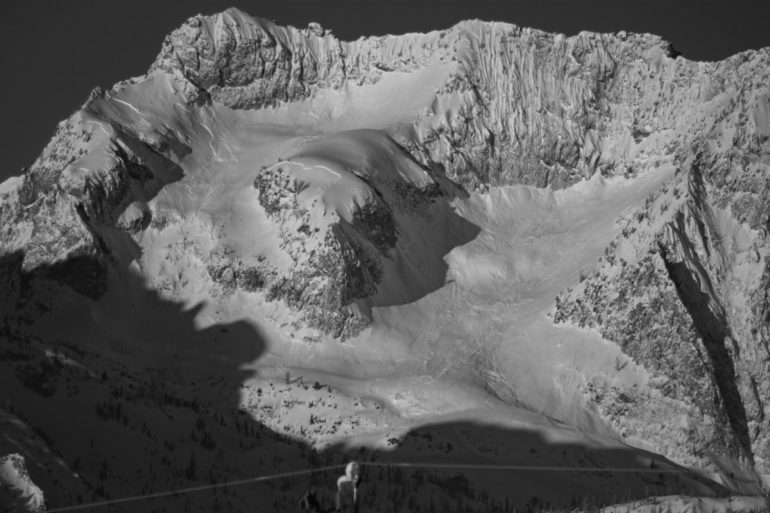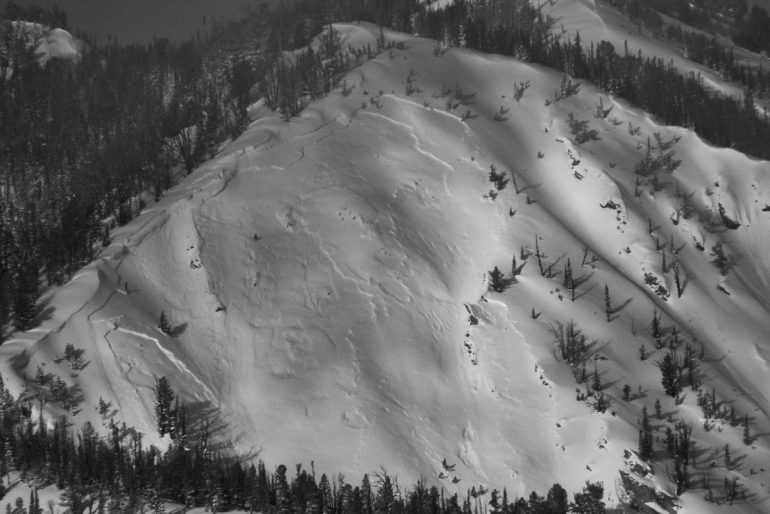
On March 31, a 6.5 magnitude earthquake shook Central Idaho, releasing thousands of Avalanches in the Sawtooth mountains, including Merritt Peak. Photo: Tanner Haskins
Avalanches, face shields, more avalanches
I keep wanting to start a post with the phrase As the World Turns, borrowed from a sleepy soap opera that aired for 54 years on CBS, only I replace ‘turns’ with ‘ends’ or ‘burns’. That’s about as far as I get because the last thing the internet needs is another depressing headline like ‘As the World Burns’. I don’t actually like soap operas and don’t recall ever seeing an episode of ATWT (as it’s affectionately abbreviated on its Wikipedia page), but maybe that’s significant somehow, like things are really skewed if a farm girl from Pennsylvania who grew up without TV is thinking about soap operas.
Soaps aside, how about skiing? Truth told, we’ve had some quiet days here at WS HQ. We had planned a bustling spring run of content oriented around ski mountaineering, adventure skiing and celebrating the stable snowpack and high country playground of spring. But then Covid, social distancing, risk aversion and the whole world essentially being brought to a shuddering halt. Our editorial pipedream got tossed out the window (or put on hold; we aren’t sure yet). Ad dollars too, as the outdoor industry is shakes in its boots and wearily eyes the crashing economy.
But, the world does keep turning, however different that may feel these days. Here’s a roundup of the latest happenings in it including spring avalanches in Colorado, a ski manufacturer turning to medical equipment, a 6.5 magnitude earthquake in the Sawtooths and the funnest ski touring film ever made indoors.
Spring avalanches in Colorado
If one thing has been proven during Colorado’s lockdown, it’s that nothing can quiet the sweet siren call of backcountry skiing. While many recreational skiers are opting for safer, mellower outings, news reports indicates that some aren’t. Last week, the CAIC reported 11 skier-triggered avalanches, including a fatal accident on Red Peak outside of Silverthorne, Colorado (report here). Two snowmobilers were also caught in a slide near Independence Pass that swept the duo into a treed gully below. One rider broke his leg and necessitated a Flight For Life helicopter ride. More here. Then, this past Friday, skiers flocked to Aspen Highlands to enjoy the 16 inches of fresh powder that filled Aspen Highlands Bowl. One skier triggered a small slide that he walked away from unhurt, though down one ski. Another small pocket ripped nearby in the bowl. Also that day, a group of skiers triggered a slide near Snowmass Ski Area. No one was hurt.
It’s tough to know what to make of avalanches during the current social, political and cultural climate. Stay at home orders, social media campaigns like #curbyourturns and ski shaming on Instagram and Facebook illustrate glaring devisions on what is appropriate behavior in trying times. Should people be skiing? Should they not? Is skiing more dangerous than, say, riding a bike? Room for discussion.
DPS turns to face shields
In lighter news, some ski manufacturers are finding other alternative applications for their engineering skills and equipment. In an effort to keep employees working and help the greater good, DPS skis turned their Salt Lake City factory into a production station for surgical face shields.
Different than the M95 masks that are in such high demand in the U.S., DPS designed a clear surgical face shield using scrap from ski bases. They re-appropriated the computer program typically used to cut the shapes of the skis and DPS logos, and used existing shields to come up with their own design. The result is a medical device approved by the Utah Department of Health can be used to protect workers.
“We were able to take our skill sets that we have in making skis and transfer it pretty quickly — this all happened in about a week — to start making shields,” said Steve Kropf, VP of Sales for DPS. He reports they had an an initial order of 10,000 shields that shipped last week. That has since grown to 20,000. The project also has had a bonus effect of bringing several brands together, including Petzl who’s contributing head straps to secure the shields, and Goal-Zero, who’s giving financial support.
Of course, DPS is still making skis too, including the long-awaited Pagoda series. They are scheduled to be released this summer.
Sawtooth earthquake unleashes avalanches
While it may be spooky to consider traveling through avalanche terrain on a high danger day, imagine doing it in the middle of an earthquake. Chris Lundy, a forecaster with the Sawtooth Avalanche center and co-owner of Sawtooth Mountain Guides found he and his wife in that position on March 31 when a 6.5 magnitude earthquake literally shook the Sawtooth Mountains in Central Idaho.
On March 31, Lundy and his wife were paying a maintenance visit to the Williams Peak Hut which had been closed for several weeks due to Covid-19. They were enjoying a glass of wine after shoveling out the yurt, which was buried from a major storm that had put avalanche danger on high, when the earthquake started.
“My first inclination being an avalanche guy was that some massive avalanche was happening, which is kind of irrational because I can’t imagine an avalanche big enough to create the chaos [outside].”
“We immediately ran out onto the deck. The trees were all swaying and shaking. All the storm snow was just kind of exploding out of the them.” Residents of nearby Stanley, 5-10 miles away as the crow flies, even reported hearing avalanches.
The yurt was undamaged, so after calling a neighbor to check on the status of their house, Lundy and his wife decided to stick with their plan to stay the night. The next day they toured under clear skies to Skier’s Summit, a nearby highpoint that overlooks several basins. On the way they crossed an avalanche slope that Chris reported having seen slide only one other time.
“Once we started getting into steeper terrain, say 25-35 degrees, the first thing we noticed was that the snowpack was pretty shattered. There were cracks going every which way.” At the top of Skier’s Summit they saw a bunch of natural avalanches. “Pretty much everything that was over 40 degrees had snow come off of it in some way, shape or form, whether it was a slab avalanche, a sluff, hanging snowfields released, just massive amounts of snow had moved off of the mountains.”

Multiple avalanches occurred on the Smokey Mountains area of the Sawtooths. Photo: Ben VandenBos/Sawtooth Avalanche Center
Lundy called the earthquake significantly larger than anything he’s witness in the 16 years he’s lived in the area. Small earthquakes are relatively frequent but large earthquakes are fairly uncommon. There’s been a handful of documented cases of earthquakes triggering avalanches, but that phenomenon is not well understood. The most recent earthquake of this magnitude occurred in 1983.
“This event seemed unique in that it didn’t produce one massive avalanche, like what happened on Everest that killed a lot of climbers a few years ago, but produced thousands of small to medium sized avalanches,” Lundy continued. “I’ve looked at a lot of avalanches in my day and these just had a different appearance to them.” For more info, check out this explanatory video from College of Southern Idaho Geology Professor Shawn Willsey.
A really fun ski edit
If you want some inspiration for how to fill those long lockdown days, look no further than Freeride Skiing at Home – A Ski Movie By Philipp Klein. If that guy can make a full ski film in a 100 square foot space without even going outside, imagine what you could do.
Manasseh Franklin is a writer, editor and big fan of walking uphill. She has an MFA in creative nonfiction and environment and natural resources from the University of Wyoming and especially enjoys writing about glaciers. Find her other work in Alpinist, Adventure Journal, Rock and Ice, Aspen Sojourner, AFAR, Trail Runner and Western Confluence.
